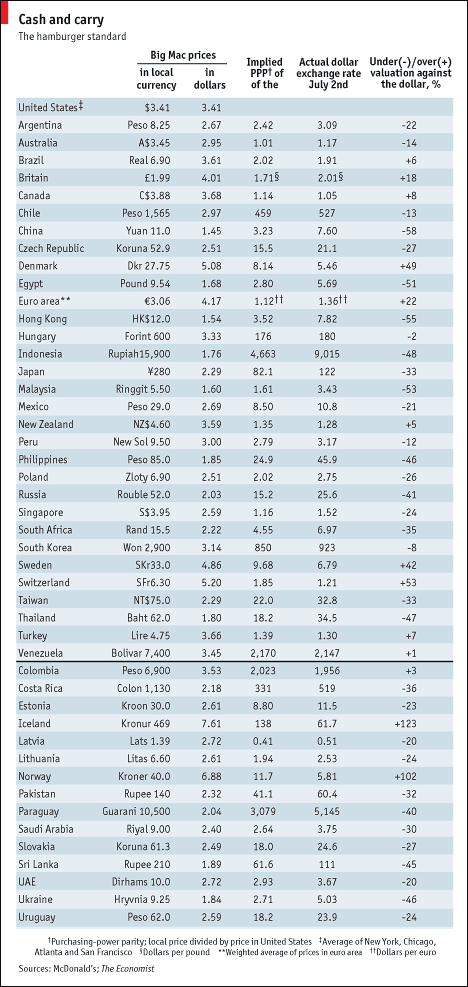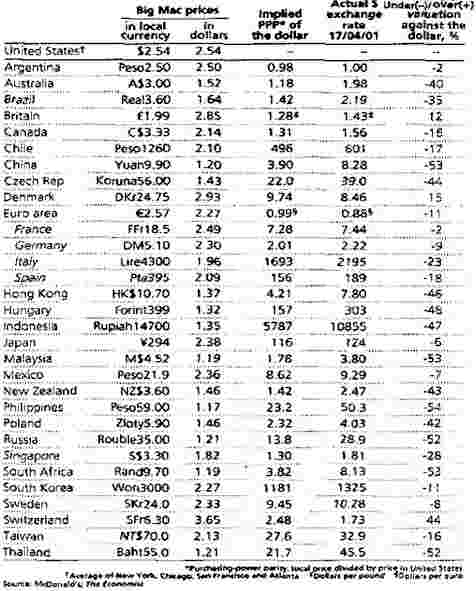Exchange-Rate Theory
Big Mac Currencies - 2006 and 2001I went into a McDonald's yesterday and said, "I'd like some fries." The girl at the counter said, "Would you like some fries with that?" - Jay Leno I haven't eaten at a McDonald's since I became President. - William J Clinton 2006
The Swiss franc, like the yen a source of low-yielding funds for foreign-exchange punters, is 53% overvalued. The franc's recent fall is a rare example of carry traders moving a currency towards its burger standard. That is because it is borrowed and sold to buy high-yielding investments in rich countries such as New Zealand and Britain, whose currencies look dear against their burger benchmarks. Brazil and Turkey, two emerging economies favoured by speculators, have also been pushed around. Burgernomics hints that their currencies are a little overcooked. Source: economist.com 5 July 007
2001: The Economist's Big Mac Index of Currencies Offers Food for ThoughtIt is time for our annual bite at burgernomics. The Economist's Big Mac index was first launched in 1986 as a gastronome's guide to whether currencies were at their correct exchange rate. It is not intended to be a precise predictor of currency movements, but simply a way to make exchange-rate theory a bit more digestible. Burgemomics is based upon one of the oldest concepts in international economics: the theory of purchasing-power parity (PPP). This argues that the exchange rate between two currencies should in the long run move towards the rate that equalises the prices of identical bundles of traded goods and services in each country. In other words, a dollar should buy the same amount everywhere. Our "bundle" is a McDonald's Big Mac, which is produced to more or less the same recipe in about 120 countries. The Big Mac PPP is the exchange rate that would leave hamburgers costing the same in each country. Comparing a currency's actual exchange rate with its PPP is one test of whether the currency is undervalued or overvalued. The first column of the table shows local-currency prices of a Big Mac; the second converts them into dollars. The average price of a Big Mac in America is $2.54 (including sales tax). In Japan, Big Mac scoffers have to pay ¥294. or $2.38 at current exchange rates. The third column calculates PPPs. Dividing the yen price by the dollar price gives a Big Mac PPP of ¥116. Comparing that with this week's rate of ¥124 implies that the yen is 6% undervalued. The cheapest Big Macs are found in China, Malaysia, the Philippines and South Africa, and all cost less than $1.20. In other words, these countries have the most undervalued currencies, by more than 50%. The most expensive Big Macs are found in Britain, Denmark and Switzerland, which by implication have the most overvalued currencies. Sterling, for example is 12% overvalued against the dollar - less than two years ago, it was overvalued by 26%. The greatest triumph of the Big Mac index has been in tracking the euro. When Europe's new currency was launched in January 1999, virtually everybody predicted that it would rise against the dollar. Everybody, that is, except the Big Mac index, which suggested that the euro started off significantly overvalued. One of the best-known hedge funds, Soros Fund Management, admitted that it chewed over the sell signal given by the Big Mac index when the euro was launched, but then decided to ignore it. The euro tumbled; Soros was cheesed off. The average price today in the 12 euro countries is €2.57, or $2.27 at current exchange rates. The euro's Big Mac PPP against the dollar is €1=$0.99, which shows that it has now undershot McParity by 11%. That, in turn, implies that sterling is 26% overvalued against the euro. Overall, the dollar has never looked so overvalued during 15 years of burgernomics. In the mid 1990s the dollar was cheap against most currencies; now it looks dear against all but three. The most undervalued of the rich-world currencies are the Australian and New Zealand dollars, which are both 40-45% below McParity. They need to ketchup. All the emerging-market currencies are undervalued against the dollar on a Big Mac PPP basis. That, in turn, means that a currency such as Argentina's peso, which is undervalued only a tad against the dollar, is massively overvalued compared with other currencies, such as the Brazilian real and virtually all of the East Asian currencies. Some of our readers find the Big Mac index hard to swallow. Not only does the theory of purchasing-power parity hold only for the very long run, but hamburgers are a flawed measure of PPP. Local prices may be distorted by trade barriers on beef, sales taxes, or big differences in the cost of property rents. Nevertheless, some academic studies of the Big Mac index have concluded that betting on the most undervalued of the main currencies each year is a profitable strategy.
Source: The Economist 21 April 2001
The word "economics" itself originally meant "care of the household" - perhaps "burgernomics" really means "care of the burger"?
Clicking the "Up" button below will return/take you to the page containing a parity table updated for 2002 |
 Animals
Animals Animation
Animation Art of Playing Cards
Art of Playing Cards Drugs
Drugs Education
Education Environment
Environment Flying
Flying History
History Humour
Humour Immigration
Immigration Info/Tech
Info/Tech Intellectual/Entertaining
Intellectual/Entertaining Lifestyles
Lifestyles Men
Men Money/Politics/Law
Money/Politics/Law New Jersey
New Jersey Odds and Oddities
Odds and Oddities Older & Under
Older & Under Photography
Photography Prisons
Prisons Relationships
Relationships Science
Science Social/Cultural
Social/Cultural Terrorism
Terrorism Wellington
Wellington Working
Working Zero Return Investment
Zero Return Investment
